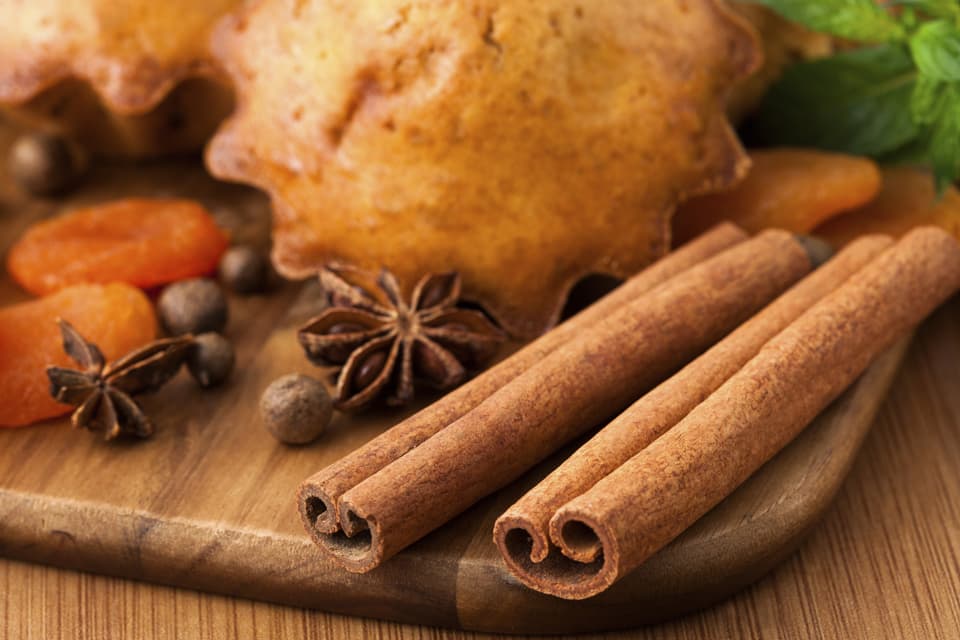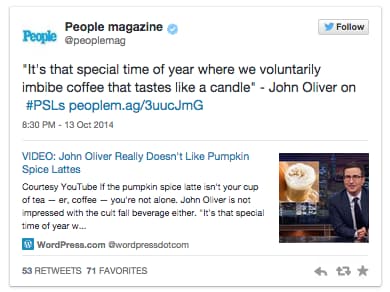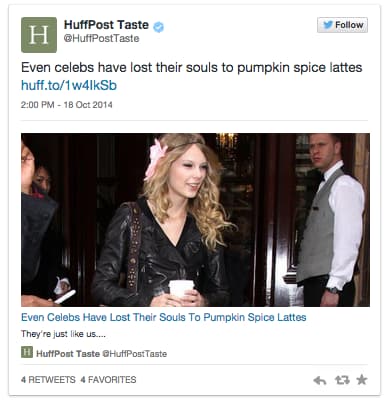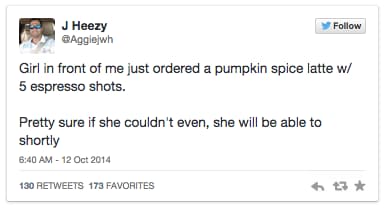Grocery aisles all over the U.S. are lined with products in cozy-looking packages of warm fall colors—pumpkin spice coffee, pumpkin spice muffins, pumpkin spice beef jerky. Wait. What? The seasonal trend of adding delightful hints of cinnamon, ginger, and nutmeg has spread from the traditional baked goods of yesteryear to unexpected (and unnecessary) goods ranging from potato chips to vodka to nail polish. In fact, the number of distinct foods in our MyFitnessPal database containing “pumpkin spice” in the description has jumped from 212 in January 2009 to almost 44,000 to date. Holy autumn treats.
In response to the surge of pumpkin spice products and their passionate (often young, white, female) fans, a sort of pumpkin spice backlash has emerged. Cynics begrudge the fact that most pumpkin spice products don’t contain even a sniff of pumpkin and hope that this fad will burn itself out so pumpkins can return to their standard, sporadic appearances in pies and patches. A quick scan of Twitter shows that although people are still guzzling by the gallon, it’s become something of a collective cultural joke:
Given all the pumpkin spice preoccupation, we got curious.
The Rise (and Fall?) of Pumpkin Spice
To assess how pumpkin spice madness has grown over time, we scanned our database of over 4 million foods and 65 million users to see what percentage of foods logged over the past 5 years have had “pumpkin spice” in their descriptions. This is what we found:
Peak pumpkin spice day reliably falls in mid to late October—just like the leaves. And as you can see from the graph above, pumpkin spice consumption has been increasing continuously for the past five years. In other words, it’s definitely a thing.
However, based on our anecdotal evaluations of convenience store shelves, we were expecting to see drastic increases over the past few years, so we were surprised to see that the pumpkin spice peak in 2013 was only 13% higher than the year before. Comparing this to the year-over-year growth rates for 2011 and 2012—44%, and 45%, respectively—it’s clear that the seasonal sensation is slowing down, and it seems we might be approaching a pumpkin spice plateau.
Carving the data another way leads to a similar conclusion: the total amount of pumpkin spice food consumed over the course of the year grew by 34% in 2011 and 46% in 2012, but only 14% in 2013. Though it’s too early to tell how things will shake out for 2014, looking at September as a leading indicator reveals that the numbers for this year and last are nearly identical, again hinting at a possible pumpkin spice stagnation. Maybe people are pumpkin-spiced out. Or maybe we’ve hit a saturation point because we’ve added pumpkin spice to absolutely everything that is physically feasible. Only time will tell.
Pumpkin Spice Season Creep
We next turned our attention to the length of pumpkin spice season. Is it just us, or does it seem to be getting longer?
To find out, we first took a look at when pumpkin spice season starts. Answer: whenever Starbucks decides that it does. Our database shows a huge surge in pumpkin spice foods every year on the release date of the infamous PSL. It tends to be right around September 1 without too much wiggle room, but they did sneak into August this year, releasing on the 25th. Declaring the beginning of fall before Labor Day weekend was a bit audacious, but surely they won’t go any earlier…right?
With that established, we assessed when pumpkin spice season ends. That’s a trickier question, as there’s no single day when consumption immediately falls off, but it does seem to be creeping steadily later. As evidence, we present to you this startling fact: in 2009, the bulk of pumpkin spice food entries in MyFitnessPal dropped off on January 5, whereas last year they stretched all the way until March 1. In total, it stretched an extra 51 days–that’s over seven extra weeks of pumpkin spice madness! (See below for methodology.)
Sure, pumpkin spice season started a smidge earlier this year, but the real headline here is that it’s creeping from fall all the way through winter, and now it has it’s cinnamony sights set on spring. Before you know it, we could be looking at pumpkin spice peeps and jelly beans.
Top 10 Pumpkin Spice Foods
Having discovered that pumpkin spice season starts with Starbucks’ PSL, we wanted to know if it was single-handedly responsible for the trends in our data, or if there are other, similarly popular pumpkin spice treats. So, we dug up the top 10 most popular pumpkin spice foods in the MyFitnessPal database for October 2014. Spoiler alert: Coffee Mate’s at-home creamer actually beat out its pricey coffee-shop competitor. It’s also interesting to note that although the market is lousy with all manner of pumpkin spice treats, it’s still coffee or things you would eat with coffee that have captured our hearts, minds, and calories.
We love that two of the top ten pumpkin spice foods were homemade. If you’re in the pro-pumpkin spice camp, here are a few recipes you can try yourself:
Harvest Salad with Creamy Pumpkin Balsamic Vinaigrette
Pumpkin Spice Pancakes
Pumpkin Pie Power Bites
Spicy, Not Sinful Pumpkin Spice Latte
6 Delicious Ideas for Pumpkins & Squash
What do you think of pumpkin spice? Is it love, hate, or love/hate? Tell us in the comments.
Methodology
To examine the consumption of pumpkin spice foods over time, we counted all of the foods logged every day from the beginning of 2009 until October 14, 2014 that had “pumpkin spice” listed in the description. Then, to control for the general growth of our database over time, we divided that number by the number of overall foods logged on each day.
We defined the end of pumpkin spice season as the day when the percentage of pumpkin spice foods logged dropped below 0.02%, which was at or near the off-season pumpkin spice consumption rate for most years.










